Kuril Islands Dispute between Japan and Russia

Kuril Islands Dispute between Japan and Russia
After World War II, the Kuril Islands dispute (also known as the Northern Territories) became a point of contention between Russia and Japan. It involves ownership of the four southernmost islands: Iturup, Hikotan, Kunashir, and Habomai.
This area is among the 56 islands in a chain stretching from the Russian Kamchatka Peninsula to the Japanese island of Hokkaido. Despite their small sizes, these islands are of immense strategic importance to the Russians, who refused to surrender the region after having captured it by the end of the World War II.
In this post, we explore the intricacies of the Kuril Islands dispute from 1945 (when Russia took control) to today.
Why do the Russians want to keep Kuril Island?
The Kuril Islands offer both political and military advantages for Russia. First, their geographic location makes it easy for Russia to maneuver its massive Pacific fleet in the Vladivostok base to the Pacific Ocean. Alternative routes would make transport extremely difficult, particularly in the sub-zero temperatures of winter.
Furthermore, surrendering the Kuril Islands threatens Russia’s sovereignty. How? The Japanese can quickly build military bases on the islands and potentially use them to deploy long-range missiles in the event of war. Moreover, Japan’s close relationship with the U.S. could see the U.S. setting up a military base on the Nansei Islands. Besides that potential threat, Russia would have to accommodate foreign-owned military ships in the Sea of Okhotsk (considered a Russian jurisdiction).
Previous attempts to resolve the Kuril Islands dispute.
The original dispute arose from ambiguity stemming from disagreements on the meaning of the Yalta agreement (February 1945) and the Potsdam Declaration (July 1945) at the end of World War II. As part of these agreements, Japan had to relinquish control of the Kuril Islands. Russia wasn’t explicitly authorized to take charge, but it did.
In 1951, the San Francisco Treaty was supposed to be a permanent peace treaty between the Allied Forces and Japan. The agreement meant that Japan had to renounce all rights to the Kuril Islands, which it did. However, at that time, the Japanese government and media claimed that the four southernmost islands were not part of the treaty.
In 1956, through the Soviet-Japanese Joint Declaration, the Soviet Union proposed to settle the dispute by returning Habomai and Shikotan to Japan. Although the Japanese were keen to accept the proposal, disagreements emerged over the interpretation of the territorial provisions of the declaration, leading to a sustained dispute.
Kuril Island disputes in recent years.
Russian President Vladimir Putin met with the then-Japanese Prime Minister Shinzo Abe in 2018. They agreed to resolve disputes based on the 1956 declaration.
In 2021, Putin proposed a special economic zone on the Kuril Islands. This proposal would enforce Russian law on the islands and allow companies to operate tax- and property-free for 10 years. This proposal met with severe resistance from the Japanese government.
The final blow came when the Japanese imposed sanctions on Russia due to the Ukraine war in March 2022. In response, Russia suspended all talks on the Kuril Islands’ ownership.
Only time will tell if Russia will return the Kuril Islands to Japan. As it stands now, doing so will put Russia at a strategic disadvantage, making such a prospect unlikely in the near future.










